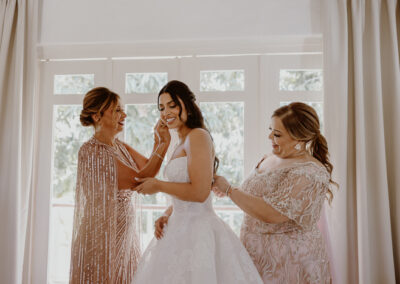How Much Should a Dress for a Wedding Cost?
When you’re planning a wedding, deciding how much to spend on a dress can be a tricky balance. You’re likely aware that wedding dresses can range from a few hundred dollars to tens of thousands, depending on factors like designer labels and fabric quality. But how do you determine what’s reasonable for your budget without sacrificing style and elegance? It’s not just about the dress itself; alterations, accessories, and preservation also add to the total cost. So, how do you prioritize and manage these expenses while ensuring your special day remains within budget? Let’s explore this further.

General Wedding Dress Costs
When budgeting for a wedding, understanding the cost of the dress is essential. You’ll find that wedding dress materials and designer brand comparisons play a significant role in pricing. On average, expect to spend $1,500 to $2,500 on a dress in 2025. However, luxury and couture options can range from $2,000 to $4,000, while designer and custom dresses may exceed $5,000. If you’re budget-conscious, affordable bridal shops offer dresses under $500. Consider regional differences: in the USA, dresses cost $1,600 to $2,000, while in Europe, prices vary from €1,000 to €2,500. Styles also affect costs, with A-line gowns ranging from $500 to $5,000. By understanding these factors, you can make an informed decision that suits your budget. Don’t forget to factor in alteration costs, which can range from $75 to $300+, depending on the complexity of the changes needed.
Factors Influencing Price
Understanding the factors influencing wedding dress prices helps you make smart choices that align with your budget. Fabric quality plays a significant role; high-quality options like silk, charmeuse, and Chantilly lace can elevate costs. Consider the origin and sourcing of fabrics, as rare materials increase expenses. Designer influence is another key factor. Renowned designers or gowns from new collections typically come with hefty price tags. On the other hand, local designers may offer more affordable alternatives without sacrificing style. Don’t overlook construction details: intricate embellishments and superior craftsmanship, such as corseting and boning, add to the overall cost. Handmade elements, like beading, also drive up labor costs. Setting a budget before shopping is crucial to avoid overspending. Balancing these factors allows you to find a dress that fits your budget and vision.
Cost Trends Over Time
As you consider the various factors influencing the cost of your wedding dress, it’s helpful to explore how these prices have evolved over time. In 2005, with most dresses made in America, the average price was $678. By 2016, this rose to between $1,000 and $2,000, largely due to overseas manufacturing. Fast forward to 2023, and you’ll find the average cost is around $2,000. The popularity of strapless gowns in the late 2000s contributed to a shift in styles that often included higher price tags due to increased demand. Regional differences also play a significant role. For instance, the Mid-Atlantic region averages over $2,200, while the Midwest is about $1,900. International destination weddings can push the average dress cost to nearly $2,800. Understanding these historical prices and regional variations helps you make informed decisions when planning for your special day.
Budgeting Strategies
Crafting a budget for your wedding dress is an essential step to guarantee you stay within your overall wedding financial plan. Start by allocating about 10% of your total wedding budget for the dress, alterations, and accessories. Break down these costs to avoid surprises. Consider dress financing to spread out expenses or explore rental options to save considerably. Renting or borrowing gowns is a practical choice that can drastically cut costs. Don’t forget to factor in additional expenses like veils, shoes, and jewelry, which can add $200 to $500. Pre-owned gowns offer substantial savings and eco-friendly benefits. Planning for potential costs, such as alterations, helps create a flexible budget, ensuring you can adapt without compromising your dream look. Exploring options like off-the-rack dresses can further help in managing costs by providing immediate availability and reducing the need for custom alterations.
Comparing High-End and Affordable Options
How can you make a smart choice between high-end and affordable wedding dresses without compromising on style or quality? Start by considering what matters most to you: the brand, design, or budget. High-end styles from designers like Vera Wang or Monique Lhuillier at luxury bridal boutiques can range from $2,000 to over $15,000, offering custom designs and premium materials. Alternatively, affordable options from retailers like David’s Bridal or online boutiques provide classic styles for $500 to $2,000. Focus on the features you value, such as material quality or design complexity. Remember, affordable doesn’t mean compromising on elegance. In the United States, brides spend an average of $1,631 on wedding dresses, excluding accessories, indicating a wide range of budget possibilities. Compare choices wisely, understanding that a well-chosen dress can shine without breaking the bank. Prioritize what truly fits your vision and budget.
Additional Dress Expenses
While planning your wedding dress purchase, it is crucial to consider additional expenses beyond the initial cost of the gown. Alteration fees can range from $150 to $1,000, depending on the complexity and number of fittings, averaging around $450. Hemming alone might set you back $70 to $280, and tailoring costs about $30 to $40 per hour. Don’t forget accessory expenses, which can add another $200 to $500 to your budget for shoes, veils, and jewelry. These costs can vary based on style, designer, and any customizations. Designer-created gowns are generally more expensive than regular gowns, so keep this in mind when budgeting. Also, factor in shipping and sales tax, especially if you’re ordering from out-of-state. Allocating roughly 10% of your wedding budget to cover these expenses will help you manage your finances smoothly.



